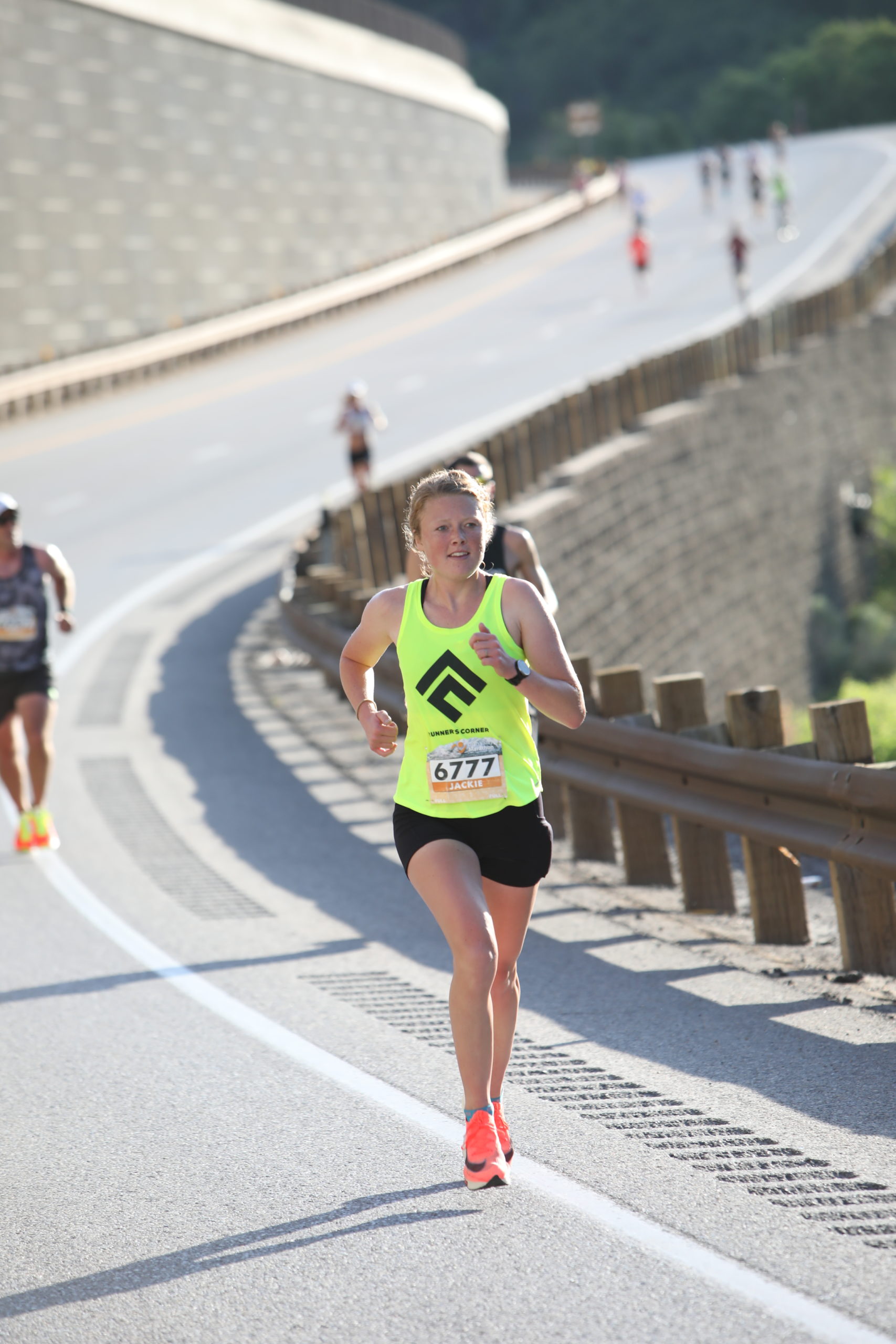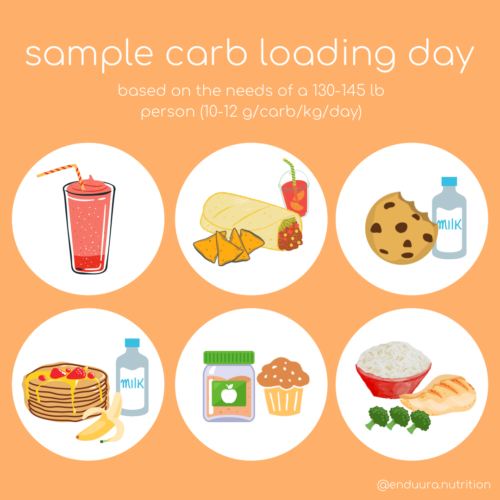Is Carb-Loading Necessary? Is There A Better Way?

Pasta. Potatoes. Pancakes. Oh my! It’s the week of your race and you’ve heard a lot about “carb loading,” but aren’t sure if it’s worth the effort. Is Carb-Loading Necessary? Will it really help my race? How many carbs do I actually need? I don’t typically eat like this – how will it affect me on race day? Is fat adaptation just as good? If these questions have ever come up for you before – keep reading!
What is Carb Loading?
Carbohydrate is the most abundant nutrient used by an endurance athlete for fuel. It is our body’s preferred source of energy. An estimated 65-85% of energy used during a run, swim, or bike comes from carbohydrate because it is easily accessible. The higher the intensity of the event, the higher the amount of carbohydrate is utilized.
Our body stores carbohydrates as glycogen. That glycogen (stored carbohydrate) is used during our daily training runs, rides, and races to give you the energy you need to keep moving forward. Without carb loading, most people typically have enough glycogen stores to last for about 2 hours before those stores decline rapidly. This decline is not something that can be fixed by gels and chews during your event. Your body is not focused on storing glycogen when it is rapidly using it during exercise.
Many athletes tend to “hit the wall” around the 2 hours mark, and significantly slow their pace partially due to a lack of stored fuel. For this reason, it’s important for endurance athletes competing in events 2 hours or longer to supercomensate their glycogen stores by carb loading in the few days leading up to the race.
Is Carb Loading Beneficial?
Carb loading has been shown to improve endurance performance in events lasting longer than 2 hours by 2-3%. This may seem meaningless, but in an Olympic-distance triathlon taking 3 hours to complete, carb loading has the potential to shave off 5 minutes from your previous best time. That’s pretty significant.
For shorter events, carb loading will not have the same effect. This doesn’t mean carbohydrate is no longer important – but you can relax on over-stocking your stores and just eat adequate amounts of daily carbohydrate as usual.
How Do I Carb Load?
There are a few carb loading strategies out there. The most common recommendation I give is the classic 3-day carb load, and here’s why: both the classic 6-day and classic 3-day carb load are equally effective, but the 6-day requires more thought & energy during the first 3 days of low carbohydrate intake that is ultimately unnecessary. 1-day carb loads can be effective as well, and don’t take as much time and energy to implement into your training. I would use this strategy most often during training on the day before you have an extra long day ahead of you. Practicing carb loading during your training cycle will help you know what to expect come race day & know which strategy works best for you.
Classic 6-Day Carb Load
- 3 days low carbohydrate intake (4-4.5 g carb/kg body weight) + high intensity training
- 3 days high carbohydrate (10-12 g carb/kg body weight) + light, low intensity training or rest
- RACE DAY
Classic 3-Day Carb Load
- Start with 1 high intensity workout followed by….
- 3 days high carbohydrate (10-12 g carb/kg body weight) + light, low intensity training or rest
- RACE DAY
1-Day Carb Load
- 1 day high carbohydrate (10-12 g carb/kg body weight) + light, low intensity training or rest
- RACE DAY
Here’s a reference of what 10-12 g carb looks like PER DAY for a 130-145 pound person. For most athletes, simply focusing on “eating more carbs” will be an inadequate strategy to assure you are getting enough. Consider tracking your grams of carbohydrate for the 3 days leading up to your race to assure adequate intake before race day. You can do this on a piece of paper using a simple calculator to add it up, or download an app (like My Fitness Pal) that tracks macronutrient grams. With that said, please remember that tracking is meant to be used as a helpful tool from time to time, particularly when a nutrition recommendation doesn’t feel normal or natural, but not something I would recommend doing chronically.
Carb Loading Tips
- Don’t try to maintain your normal protein & fat intake during a carb load. Your diet will be unbalanced on these days, and that is OK when you have specific performance goals you are preparing for. Aim for roughly 60-70% of your calories to come from carbohydrate.
- Choose low fiber foods (white rice, white bagels, pretzels, etc.). This will help your stomach not feel as full & allow your body to store the glycogen more efficiently. It will also prevent GI distress caused from excess fiber.
- Supplement with high carb beverages if you’re having a hard time eating and chewing adequate amounts of carbohydrate. Tailwind, Maurten 360, Gatorade, and Powerade are all good options for carb loading.
- You may feel bloated or “fluffy” and that’s expected, it means you’re doing it right.
- Any weight gain you experience is likely water weight from the increased carb intake and will not hurt your performance on race day.
What About Fat Adaptation?
Fat adaptation is a strategy some people promote as an alternative to carb loading. Essentially, an athlete who is fat adapted trains their body to rely on fuel sources other than carbohydrate during exercise to promote optimal performance. In theory, an athlete who is fat adapted could rely on both fat and carbohydrate reliably for energy, thus preventing a major bonk due to low glycogen stores.
Athletes who “train low” or with little carbohydrate availability can in fact increase their ability to utilize fat as an energy source during exercise. What has not been shown clearly in research, however, is whether or not any performance benefit happens for a fat adapted athlete. From what we can tell, fat adapted athletes may be able to perform equally to a carbohydrate-dependent athlete, but not better. So until the research is clear that I’ll be able to run faster without my carbohydrates, I’ll keep my pantry stocked with my favorite carbohydrate-rich fuel.
Wrapping It All Up
Is carb-loading necessary? In conclusion, carb loading is a beneficial nutrition strategy that can improve your endurance performance by 2-3% in events lasting 2 hours or more in duration. Most commonly, a 3-day carb load of 10-12 g carb/kg body weight will be the best option for an athlete. Carb loading is made easier by consuming low-fiber foods, drinking carbohydrate-rich beverages, and lowering your protein and fat intake. Athletes looking to improve their performance through fat adaptation should understand that while fat adaptation does create metabolic changes in the body, it does not however improve an athlete’s performance beyond typical carbohydrate-dependence.
References
- Murray B, Rosenbloom C. Fundamentals of glycogen metabolism for coaches and athletes. Nutr Rev. 2018;76(4):243-259. doi:10.1093/nutrit/nuy001
- Thomas DT, Erdman KA, Burke LM. Position of the Academy of Nutrition and Dietetics, Dietitians of Canada, and the American College of Sports Medicine: Nutrition and Athletic Performance. J Acad Nutr Diet. 2016 Mar;116(3):501-528. doi: 10.1016/j.jand.2015.12.006. Erratum in: J Acad Nutr Diet. 2017 Jan;117(1):146. PMID: 26920240.
- Rosenbloom, C. A., PhD, RD, CSSD. (2012). Carbohydrates and Exercise. In 1153665439 867118439 E. J. Coleman MA, MPH, RD, CSSD (Ed.), Sports Nutrition: A Practice Manual for Professionals (5th ed., pp. 134-135). Chicago, IL: Academy of Nutrition and Dietetics.
- Burke LM, Hawley JA. Effects of short-term fat adaptation on metabolism and performance of prolonged exercise. Med Sci Sports Exerc. 2002 Sep;34(9):1492-8. doi: 10.1097/00005768-200209000-00015. PMID: 12218744.
- Burke LM, Whitfield J, Heikura IA, Ross MLR, Tee N, Forbes SF, Hall R, McKay AKA, Wallett AM, Sharma AP. Adaptation to a low carbohydrate high fat diet is rapid but impairs endurance exercise metabolism and performance despite enhanced glycogen availability. J Physiol. 2021 Feb;599(3):771-790. doi: 10.1113/JP280221. Epub 2020 Aug 19. PMID: 32697366; PMCID: PMC7891450.

Jackie Hendrickson RD, MPH is a registered dietitian with a Masters Degree in public health nutrition from Utah State University. Jackie is the owner of Enduura Nutrition and loves coaching her athletes to their athletic potential through sustainable training & nutrition principles. She is an avid road & trail marathoner with a background in collegiate track, cross country, and competitive swimming. Jackie and her husband, Adam, were teammates in college and continue to pursue their running goals together. They live in beautiful Ogden, Utah with their 2 year old son, Lincoln.









